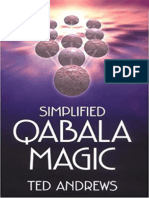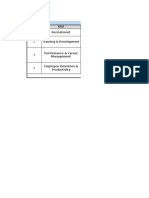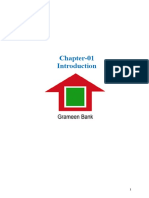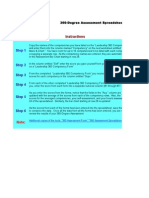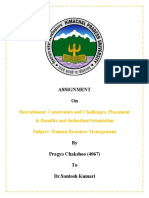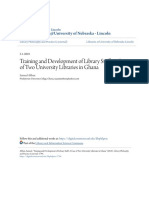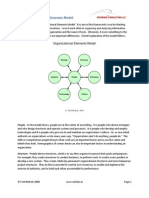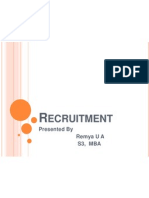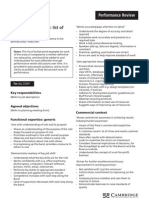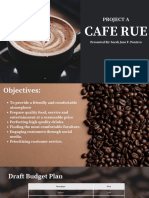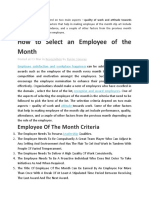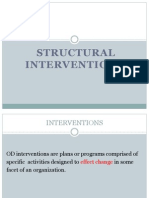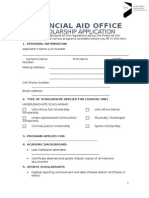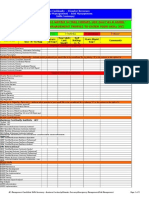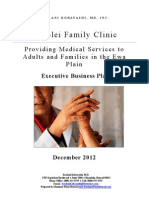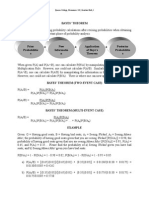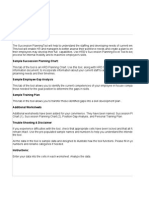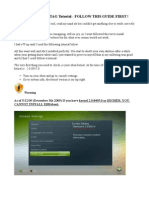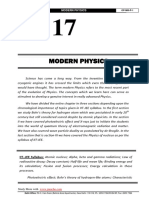Recruitment Plan Template
Recruitment Plan Template
Uploaded by
zahoor80Copyright:
Available Formats
Recruitment Plan Template
Recruitment Plan Template
Uploaded by
zahoor80Original Title
Copyright
Available Formats
Share this document
Did you find this document useful?
Is this content inappropriate?
Copyright:
Available Formats
Recruitment Plan Template
Recruitment Plan Template
Uploaded by
zahoor80Copyright:
Available Formats
Workforce planning Workforce planning information is beneficial in the process of developing a workforce plan.
It involves achieving our desired profile through: forecasting future needs for employees in different roles, predicting the availability of such employees, and developing strategies to match supply with demand.
Vacancy is identified
Approval to recruit is sought Approval to fill positions and that the local area may have specific approval processes as well. The clearly identifies the rationalization underpinning the need to recruit by providing: a clear understanding of the need for the position the key role of the position how the position fits into the e isting structure the alternatives considered by the manager agreed workforce planning priorities!needs budget implications
Duties, tasks and responsibilities are defined Job analysis "ob analysis involves a systematic investigation of #obs using a variety of methods, to determine essential duties, tasks and responsibilities. "ob analysis is crucial to the identification of relevant skills and competencies. It involves obtaining ob#ective and verifiable information about the actual re$uirements of a #ob, and the skills and competencies re$uired to meet the local area and %niversity&s needs. "ob analysis facilitates accurate recruitment and selection practices, sets standards for performance appraisals and allows appropriate
classification!reclassification of positions. 'omparing the skills possessed by employees with the results of #ob analysis can greatly assist in workforce planning strategies and restructuring or redesigning #obs to reflect the re$uirements of the local area
Position description is written The position description should provide applicants with a clear indication of the duties, accountabilities and outcomes e pected of the position. The position description is the base document used in the management of the employee&s performance as outlined in the %niversity&s performance management scheme. If there is already an e isting position description this should be reviewed before the start of a selection and recruitment process. A position description provides information relating to a role at a given point of time, however few positions remain the same over a long period of time, hence the need for review. The position description is a key document in the process as it provides a clear picture of the position to the members of the selection panel and to the potential candidates and should accurately reflect the nature of the role and the re$uired sills, knowledge and attributes (selection criteria) necessary for successful performance in the role. It should also identify core relationships such as client groups, that the appointee may need to establish and maintain.
Position is evaluated Job evaluation and classification overview "ob evaluation is the process used to measure the relative #ob worth of positions within an organization at a point in time. It focuses on actual re$uirements of the position, not on a person or their performance and measures the content!work value and not the volume of work. The work value of the position is dependent on a range of factors including the e perience, skills and training re$uired to perform the duties and responsibilities of the position. *ecruitment planning enables the manager to consider a process and strategy to: +arket the benefits of becoming an employee of the %niversity of ,A to potential applicants. Identify and communicate the %niversity&s uni$ueness to potential applicants.
'reate an -ideal-!-high performing- employee profile. %tilise innovative talent sourcing methods (eg . creative advertising strategies). *ecruit internationally. +aintain consistency and fair treatment of all applicants. /ighlight the work areas strengths %se appropriate applicant assessment methods. 0valuate the selection practices in an effort to ensure continuous improvement of the recruitment and selection practices. i!e as appropriate Who
Custo
1inalize #ob description Approve advertising sources 2btain estimates and approvals 3lace ads 'ollect resumes 0valuate effectiveness of advertising efforts 4egin review of resumes Interview candidates *efer finalists to 5epartment /ead 5epartment /ead interviews finalists 'heck references
You might also like
- Simplified Qabala Magic by TedDocument190 pagesSimplified Qabala Magic by TedYaprak A100% (11)
- Sample KPI For HR ManagerDocument3 pagesSample KPI For HR Managerzahoor8057% (7)
- Probability of GodDocument10 pagesProbability of Godzahoor80No ratings yet
- SSK HR - Policies-HrDocument45 pagesSSK HR - Policies-HrManish KumarNo ratings yet
- New Employee Orientation Program-Group 1Document11 pagesNew Employee Orientation Program-Group 1Nova Princess Engracia Parojinog-echavez50% (2)
- Office Rules and BehaviorDocument13 pagesOffice Rules and Behaviorapi-284317024100% (1)
- Manpower Planning Grameen Bank (GB)Document52 pagesManpower Planning Grameen Bank (GB)SharifMahmud100% (2)
- Skills Matrix TemplateDocument1 pageSkills Matrix Templatezahoor80No ratings yet
- 360 Assessment Spreadsheet - 120226Document3 pages360 Assessment Spreadsheet - 120226zahoor80No ratings yet
- 4 WB Group Uav TechnologyDocument48 pages4 WB Group Uav Technologycroffle.inNo ratings yet
- Recruitment & Selection Hiring ProcessDocument25 pagesRecruitment & Selection Hiring ProcessShreekumar0% (1)
- Recruitment &45 Selection Hiring ProcessDocument20 pagesRecruitment &45 Selection Hiring Processnahidul202No ratings yet
- Recruitment PlanDocument3 pagesRecruitment Plancreativealley50% (2)
- Compensation PolicyDocument1 pageCompensation PolicyArm Arm009No ratings yet
- Recruitment, Placement, Induction & OrientationDocument6 pagesRecruitment, Placement, Induction & OrientationPragya ChakshooNo ratings yet
- Janukie Thiloshini OHS Case Study 1 13320 1768835238Document14 pagesJanukie Thiloshini OHS Case Study 1 13320 1768835238Janukie ThiloshiniNo ratings yet
- Human Resources Recruitment Interview Questions and AnswersDocument9 pagesHuman Resources Recruitment Interview Questions and AnswersPooja Prateek JoshiNo ratings yet
- Learning & Development Strategy 2011 - 2014: Background and IntroductionDocument5 pagesLearning & Development Strategy 2011 - 2014: Background and IntroductionAlan SultanNo ratings yet
- Training and Development of Library StaffDocument27 pagesTraining and Development of Library StaffAM100% (1)
- Recruitment and SelectionDocument32 pagesRecruitment and SelectionMartin January100% (2)
- HR DepartmentDocument21 pagesHR Departmentnbaig786100% (3)
- Recruitment & Selection NISGDocument97 pagesRecruitment & Selection NISGPrateek Bhatia100% (1)
- New Employee Orientation Policy: PurposeDocument10 pagesNew Employee Orientation Policy: PurposeKristine Artes AguilarNo ratings yet
- Performance ManagementDocument31 pagesPerformance Managementpratik0202No ratings yet
- HR PolicyDocument6 pagesHR PolicyAmbientNo ratings yet
- Human Resources PresentationDocument8 pagesHuman Resources Presentationapi-299534152No ratings yet
- RecruitmentDocument9 pagesRecruitmentdinesh8maharjanNo ratings yet
- Organizational ElementsDocument3 pagesOrganizational ElementsRoy Joshua0% (1)
- Audit Report of The Human Resources ProcessDocument9 pagesAudit Report of The Human Resources ProcessMohamed EmadNo ratings yet
- RecruitmentDocument22 pagesRecruitmentTindu SurendranNo ratings yet
- Areas of Competence List of ExamplesDocument6 pagesAreas of Competence List of ExamplesJitka100% (6)
- Internship Program PolicyDocument4 pagesInternship Program Policym_ganea268973No ratings yet
- Cafe Rue Project ADocument7 pagesCafe Rue Project ASarah Jane PonteroNo ratings yet
- Performance Management Chapter 7-12Document80 pagesPerformance Management Chapter 7-12ElizabethNo ratings yet
- Strategic Human Resource ManagementDocument58 pagesStrategic Human Resource ManagementSumera Sarwar100% (1)
- What Is Human Resource Development and What Are The Functions of HRDDocument4 pagesWhat Is Human Resource Development and What Are The Functions of HRDKunal SurveNo ratings yet
- Challenge Exam - Recruitment and Selection Outline 2010Document11 pagesChallenge Exam - Recruitment and Selection Outline 2010tusharhrmNo ratings yet
- Strategic Training and DevelopmentDocument16 pagesStrategic Training and DevelopmentTerencekzn108100% (3)
- Solutions: SupportDocument14 pagesSolutions: SupportSoumya Sharma Sarangi100% (1)
- Employee of The MonthDocument7 pagesEmployee of The Monthbijoy debbarmaNo ratings yet
- Human Resources Policies and Procedures Manual - UnitDocument207 pagesHuman Resources Policies and Procedures Manual - UnitD J Ben Uzee0% (1)
- 2583 7IBI - Remina - EditedDocument16 pages2583 7IBI - Remina - EditedNjugi DeusNo ratings yet
- Study On Recuirment and Selection Process in Izon Technologies at CoimbatoreDocument33 pagesStudy On Recuirment and Selection Process in Izon Technologies at Coimbatorek eswari100% (1)
- Human Resource Management: InductionDocument68 pagesHuman Resource Management: Inductionraj chauhanNo ratings yet
- Developing HR Policies - HR Policies & Employment Legislation - HR Toolkit - HrcouncilDocument11 pagesDeveloping HR Policies - HR Policies & Employment Legislation - HR Toolkit - HrcouncilVlad Philips100% (1)
- Structural InterventionsDocument12 pagesStructural InterventionsSahilSankhlaNo ratings yet
- Strategic Training & Development InitiativesDocument7 pagesStrategic Training & Development InitiativesChandra Kant RaiNo ratings yet
- Compensation Policy: Click To Edit Master Subtitle StyleDocument24 pagesCompensation Policy: Click To Edit Master Subtitle Stylekishorinaren100% (1)
- Team Engagement Action PlanDocument5 pagesTeam Engagement Action PlanCris CavasottoNo ratings yet
- Introduction To HR and HR DepartmentDocument8 pagesIntroduction To HR and HR DepartmentNira SinhaNo ratings yet
- Organizational DevelopmentDocument71 pagesOrganizational DevelopmentGirlie CruzNo ratings yet
- Recruitment and Selection Process: HRM-Module IIDocument34 pagesRecruitment and Selection Process: HRM-Module IIArjun SanalNo ratings yet
- Coaching:: Bring Out The Best in Your EmployeesDocument20 pagesCoaching:: Bring Out The Best in Your EmployeesCarmenLarisaNo ratings yet
- Human Resource PlanDocument9 pagesHuman Resource Plangroup2sd1314No ratings yet
- Performance Appraisal: Type of Appraisal - Annual - ConfirmationDocument5 pagesPerformance Appraisal: Type of Appraisal - Annual - ConfirmationFifi Filofteia NicoletaNo ratings yet
- Recruitment and SelectionDocument57 pagesRecruitment and SelectionRAKESHNo ratings yet
- Sample Recruitment PlanDocument4 pagesSample Recruitment PlanOhiwei OsawemenNo ratings yet
- Employee Manual 2020 EditionDocument29 pagesEmployee Manual 2020 EditionLorie AnnNo ratings yet
- Module 22 Q1 Career PlanningDocument10 pagesModule 22 Q1 Career PlanningprabodhNo ratings yet
- Internal Job Posting PolicyDocument3 pagesInternal Job Posting PolicyPiyasha NathNo ratings yet
- Staff Development ProgramDocument9 pagesStaff Development ProgramtulsisubhaNo ratings yet
- Organisational DevelopementDocument50 pagesOrganisational DevelopementAmit SharmaNo ratings yet
- Procurement Team: ResponsibilitiesDocument8 pagesProcurement Team: Responsibilitiesclyde dsouza100% (1)
- Recruitment Plan TemplateDocument3 pagesRecruitment Plan TemplateShamika SawantNo ratings yet
- Scholarship Application FormDocument2 pagesScholarship Application Formzahoor80No ratings yet
- Start-Up Business PlanDocument11 pagesStart-Up Business Planzahoor80No ratings yet
- ScholarshipProgram ManualDocument13 pagesScholarshipProgram Manualzahoor80No ratings yet
- Correlation and Regression: Predicting The UnknownDocument5 pagesCorrelation and Regression: Predicting The Unknownzahoor80No ratings yet
- XXXXX (Emblem) : A Guide Manual On General Rules and Procedures Issued On XX - XX.XXXXDocument11 pagesXXXXX (Emblem) : A Guide Manual On General Rules and Procedures Issued On XX - XX.XXXXBharichalo007No ratings yet
- 5104 BCDR em RiskDocument5 pages5104 BCDR em Riskzahoor80No ratings yet
- Kobayashi Medical Practice Business PlanDocument26 pagesKobayashi Medical Practice Business Planzahoor80No ratings yet
- Bayes' Theorem: Mia!, The Probability of Having Good Seats Given That You Are Seeing Wicked (P (G/ADocument1 pageBayes' Theorem: Mia!, The Probability of Having Good Seats Given That You Are Seeing Wicked (P (G/Azahoor80No ratings yet
- WBS Feasibility StudyDocument8 pagesWBS Feasibility Studyzahoor80No ratings yet
- Project Grants Acquittal FormDocument4 pagesProject Grants Acquittal Formzahoor80No ratings yet
- 2013 Hay Group Healthcare Compensation ModulesDocument62 pages2013 Hay Group Healthcare Compensation Moduleszahoor80No ratings yet
- 2014 Budget and Planning Pack MasterDocument21 pages2014 Budget and Planning Pack Masterzahoor80No ratings yet
- Reconciliation Process FlowchartDocument9 pagesReconciliation Process Flowchartzahoor80No ratings yet
- Procurement Mapping - Understanding Procurement TypesDocument8 pagesProcurement Mapping - Understanding Procurement Typeszahoor80No ratings yet
- 19 - Correlation and RegressionDocument7 pages19 - Correlation and Regressionzahoor80No ratings yet
- Attitudes Value Systems Personality Traits / Types Personal / Professional BackgroundDocument20 pagesAttitudes Value Systems Personality Traits / Types Personal / Professional Backgroundzahoor80No ratings yet
- Checklist HR Outsourcing: M-Mandatory IA - If AnyDocument1 pageChecklist HR Outsourcing: M-Mandatory IA - If Anyzahoor80No ratings yet
- Succession Planning Template Master1 Focus - PostDocument27 pagesSuccession Planning Template Master1 Focus - Postzahoor80No ratings yet
- 360 Degree Feedback Form Template: (Mouseover This Cell To See Notes)Document1 page360 Degree Feedback Form Template: (Mouseover This Cell To See Notes)zahoor80No ratings yet
- 2.3. Exact First Order Differential Equations: Learning ObjectivesDocument19 pages2.3. Exact First Order Differential Equations: Learning ObjectivesHypo KadambariNo ratings yet
- Business Plan For Startups in IndiaDocument5 pagesBusiness Plan For Startups in IndiaexllctqvfNo ratings yet
- Liber Trigrammaton Sub Figurâ XXVII by Aleister Crowley.Document8 pagesLiber Trigrammaton Sub Figurâ XXVII by Aleister Crowley.Celephaïs Press / Unspeakable Press (Leng)100% (2)
- Mumbai Mix DataDocument9 pagesMumbai Mix DataSarita JoshiNo ratings yet
- Business CommunicationDocument5 pagesBusiness CommunicationSatya Swaroop SwainNo ratings yet
- Jan 2017Document16 pagesJan 2017saraNo ratings yet
- What Is The Difference Between A Rich Mind and A Poor Mind?Document4 pagesWhat Is The Difference Between A Rich Mind and A Poor Mind?qaisarjabbar032No ratings yet
- The Arup Journal Issue 4 1980Document28 pagesThe Arup Journal Issue 4 1980Lip Bing YongNo ratings yet
- xEou1mgASoegN1bcNFdx - Topic 5.2 Practice Sheet - Normal Distribution RevisitedDocument6 pagesxEou1mgASoegN1bcNFdx - Topic 5.2 Practice Sheet - Normal Distribution RevisitedCалават РысаковNo ratings yet
- E-Commerce in Passenger Air TransportDocument14 pagesE-Commerce in Passenger Air TransportDeepak Kumar RajakNo ratings yet
- Development Studies Notes Module 1-8 2022 WwordDocument232 pagesDevelopment Studies Notes Module 1-8 2022 Wwordletangletty07No ratings yet
- E Brochure T10 Mini TruckDocument6 pagesE Brochure T10 Mini Truckvodka_taste2882No ratings yet
- Research For ShopeeDocument3 pagesResearch For ShopeeDrakeNo ratings yet
- Course Quick View With Full TOC: AIX Internals & Performance II: Memory ManagementDocument20 pagesCourse Quick View With Full TOC: AIX Internals & Performance II: Memory ManagementRichie BallyearsNo ratings yet
- The HEC Policy On PHD Degree Programs: Need For ConsiderationDocument7 pagesThe HEC Policy On PHD Degree Programs: Need For ConsiderationInstitute of Policy StudiesNo ratings yet
- 39692Document16 pages39692Lakshman ANo ratings yet
- Complete NANDandJTAG TutorialDocument7 pagesComplete NANDandJTAG TutorialBrian HussNo ratings yet
- College of Computer Science Software DepartmentDocument4 pagesCollege of Computer Science Software DepartmentRommel L. DorinNo ratings yet
- Writing Task 1 CompleteDocument47 pagesWriting Task 1 CompleteBuat DownloadNo ratings yet
- Win in Thinking SkillsDocument77 pagesWin in Thinking SkillsBai Li100% (1)
- Efficient Sorting 1998Document73 pagesEfficient Sorting 1998pendejitusNo ratings yet
- Modern PhysicsDocument72 pagesModern PhysicsSaurav DuttNo ratings yet
- Homescan: CPS Module 2Document34 pagesHomescan: CPS Module 2mithunrecdgp100% (1)
- Tutorial 2 New SolutionDocument4 pagesTutorial 2 New SolutionSteven NimalNo ratings yet
- Foundations of Information Systems in BusinessDocument31 pagesFoundations of Information Systems in BusinesspranavgosaliaNo ratings yet
- NiceguyDocument14 pagesNiceguyCatherine RodeoNo ratings yet
- Selection of Main & Branch Circuit Breaker For Distribution Box (As Per NEC)Document13 pagesSelection of Main & Branch Circuit Breaker For Distribution Box (As Per NEC)yudo heruNo ratings yet
- LIT-10019 SunMed Greenline D Blades and Handles Rev1Document1 pageLIT-10019 SunMed Greenline D Blades and Handles Rev1Maria Jose Marin CastañoNo ratings yet
